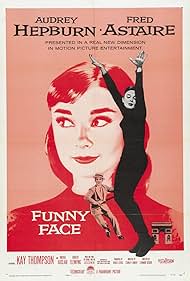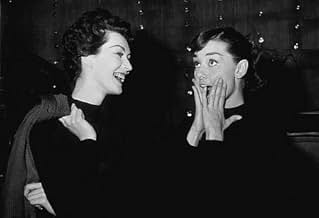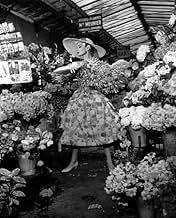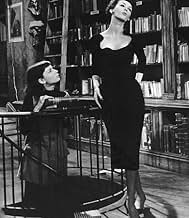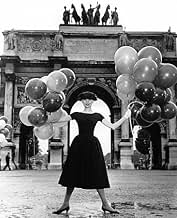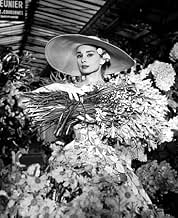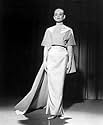An impromptu fashion shoot at a book store brings about a new fashion model discovery in the shop clerk.An impromptu fashion shoot at a book store brings about a new fashion model discovery in the shop clerk.An impromptu fashion shoot at a book store brings about a new fashion model discovery in the shop clerk.
- Nominated for 4 Oscars
- 2 wins & 10 nominations total
Heather Ames
- Junior Editor
- (uncredited)
Fern Barry
- Southern Wife
- (uncredited)
Brandon Beach
- Fashion Show Guest
- (uncredited)
Paul Bisciglia
- Photographer
- (uncredited)
- Director
- Writer
- All cast & crew
- Production, box office & more at IMDbPro
Featured reviews
The bookshop salesgirl Jo Stockton (Audrey Hepburn) is accidentally found by the photograph Dick Avery (Fred Astaire), who convinces the owner of the fashion magazine Quality, the powerful Maggie Prescott (Kay Thompson), that she could be the new model she wants for the magazine. Jo dreams on going to Paris to meet her guru, the philosopher Prof. Emile Flostre (Michel Auclair), but she cannot afford to pay for the travel; therefore she sees in the invitation, the chance to visit Paris. Once there, Dick falls in love for her.
"Funny Face" has a great cinematography, art direction, set decoration, costume design and most important, a charming and delightful Audrey Hepburn. Kay Thompson is also excellent. The problem is the silly screenplay that shows at least two great mistakes. The first one is the inconsistent and contradictory character Jo Stockton, presented as an intelligent and clever woman in the beginning, but later becoming absolutely shallow, acting like an irresponsible spoiled child. The second big mistake is Fred Astaire (58), thirty years old older than Audrey Hepburn (28), therefore more than twice her age, as her romantic pair. This great actor looks like her father, and there is no romantic chemistry between them. My vote is seven.
Title (Brazil): "Cinderela em Paris" ("Cinderella in Paris")
"Funny Face" has a great cinematography, art direction, set decoration, costume design and most important, a charming and delightful Audrey Hepburn. Kay Thompson is also excellent. The problem is the silly screenplay that shows at least two great mistakes. The first one is the inconsistent and contradictory character Jo Stockton, presented as an intelligent and clever woman in the beginning, but later becoming absolutely shallow, acting like an irresponsible spoiled child. The second big mistake is Fred Astaire (58), thirty years old older than Audrey Hepburn (28), therefore more than twice her age, as her romantic pair. This great actor looks like her father, and there is no romantic chemistry between them. My vote is seven.
Title (Brazil): "Cinderela em Paris" ("Cinderella in Paris")
This snappy musical teams an ageing Fred Astaire with the young and lively Audrey Hepburn, puts them in Paris with a lovely Gershwin score, and piles on the slush to create romantic confection that really is irresistible.
Audrey is at her best here, whether singing (in her own voice) How Long Has This Been Going On?', dancing wildly around a café, or looking like a mannequin in the fabulous frocks. Kay Thompson is on hand too, with her own fabulous number, Think Pink' about the trials and tribulations of being a fashion magazine editor.
It probably works best with the misty filters and the dreamy sequences, though. And Audrey is serenaded by Fred dancing beneath her window, like the dashing prince who comes to rescue Rapunzel. Musical corn perhaps, but addictive nonetheless.
Audrey is at her best here, whether singing (in her own voice) How Long Has This Been Going On?', dancing wildly around a café, or looking like a mannequin in the fabulous frocks. Kay Thompson is on hand too, with her own fabulous number, Think Pink' about the trials and tribulations of being a fashion magazine editor.
It probably works best with the misty filters and the dreamy sequences, though. And Audrey is serenaded by Fred dancing beneath her window, like the dashing prince who comes to rescue Rapunzel. Musical corn perhaps, but addictive nonetheless.
You have Audrey Hepburn, you have Fred Astaire, you have Gershwin songs. Who needs a plot?
Okay, there was something of a plot, something about a Greenwich Village girl who wants to go to Paris, talk b.s. philosophy on the Left Bank, wear black clothes and no make-up. It reads like something out of one of Woody Allen's early stories - before he wrote it!
Audrey Hepburn never knew how to look bad nor act bad. But in this she looks light-years more beautiful as the proverbial Greenwich Village used-book-store Plain Jane than any Paris fashion model - then or now.
Okay, there was something of a plot, something about a Greenwich Village girl who wants to go to Paris, talk b.s. philosophy on the Left Bank, wear black clothes and no make-up. It reads like something out of one of Woody Allen's early stories - before he wrote it!
Audrey Hepburn never knew how to look bad nor act bad. But in this she looks light-years more beautiful as the proverbial Greenwich Village used-book-store Plain Jane than any Paris fashion model - then or now.
This 1957 musical is a little odd. It has a title based on an original 1920s Gershwin musical (that included the title song) which starred Fred and Adele Astaire. It was a musical and scenic valentine to France (but only one tune in it deals with France - "Bonjour Paris!". It is a spoof on the modern fashion magazines, fashions in general, and advertising - but the spoof while sharp at times is never pushed. The opening sequence, "Think Pink," describes how Kay Thompson plans a campaign to make the American woman go for "pink" clothes, accessories, toothpaste, etc., only to admit to her assistant she personally loathes the color. It takes full advantage of the attractive face and features of Hepburn, who is convinced to be a model and help push a new line of fashions in Paris. And it makes two characters into imitations of Richard Avedon the photographer (Astaire as Dick Avory) and Jean-Paul Sartre (Michel Auclair as Prof. Emile Flostre).
Avedon was a rarity - a fashion photographer who became a great artistic portrait photographer. Astaire never is shown taking pictures of great or famous people in the film but several times he demonstrates a refinement that separates him from the rest of Kay Thompson's entourage (most of whom don't care what havoc they cause, as long as they get their jobs done). He also has enough sense to question Hepburn's accepting of "empathicalism", and it's viability. Witness his moment in the bistro pouring wine to the two old codgers who are quite pleasant to him while he insults them in English. Hepburn, of course, is so insistent on the validity of her philosophical beliefs that she rejects Astaire's warnings, and jeopardizes the fashion show.
The final blow (seemingly) to the Astaire - Hepburn relationship is when he confronts Flostre at the author's home. He knocks out the Professor, and his brutality demolishes the relationship with Hepburn. But within minutes Hepburn sees another side to Flostre which is unexpected, and suddenly realizes that Astaire may be right after all.
The character of Flostre is obviously based on that of Jean-Paul Sartre, the founder of "existentialism". Based on in some details, but not in theory. "Empathicalism" has to do with trying to empathize with others so as to have a proper response to their needs and aspirations. "Existentialism" has to do with: "An introspective humanism or theory of man which expresses the individual's intense awareness of his contingency and freedom; a theory which states that the existence of the individual precedes his essence." This is from Webster's New Collegiate Dictionary. Sartre has a more complex view of man and society, and one can plow through BEING AND NOTHINGNESS to try to understand it. In fact some critics have wondered if the Nobel Prize Winner eventually got very wrong headed about his theory. But he certainly seems a meatier philosopher than his celluloid copy.
But Flostre does have the trappings of Sartre on him. He is revered by his followers world wide (such as Hepburn). He is a man with sexual appetite (as Sartre was with his long time companion and fellow writer Simone Beauvoir). And there is some traces of an anti-capitalist, even anti-American attitude in him. It is not definitely pushed, but when Astaire and Thompson break into his house during a party, they pretend they are American share cropper singers whom Flostre had brought to France to perform for his guests. Now, we never hear what this actual pair actually would sing, but judging from their background they would have to throw in some protest songs. Sartre was very critical of the U.S.A. and capitalism (today his fans have to explain Sartre's willingness to accept Russian imperialist moves under Communism in the 1940s, 1950s, and 1960s - they find it very hard to do so).
On the whole the parts of the film work well, so I give it seven stars. Kay Thompson is best recalled for being the creator of the little girl at the Plaza "Eloise", but she shows here a highly entertaining performance as Maggie Prescott, the editor who pushes and loathes pink. The film would have been better if somehow Avedon's portrait photography had been brought into the story, possibly in a final scene with Flostre as his subject. However, even without such a sequence the film is rewarding to watch, especially in the musical numbers. Astaire does equally well with Thompson and with Hepburn as his partners here.
Avedon was a rarity - a fashion photographer who became a great artistic portrait photographer. Astaire never is shown taking pictures of great or famous people in the film but several times he demonstrates a refinement that separates him from the rest of Kay Thompson's entourage (most of whom don't care what havoc they cause, as long as they get their jobs done). He also has enough sense to question Hepburn's accepting of "empathicalism", and it's viability. Witness his moment in the bistro pouring wine to the two old codgers who are quite pleasant to him while he insults them in English. Hepburn, of course, is so insistent on the validity of her philosophical beliefs that she rejects Astaire's warnings, and jeopardizes the fashion show.
The final blow (seemingly) to the Astaire - Hepburn relationship is when he confronts Flostre at the author's home. He knocks out the Professor, and his brutality demolishes the relationship with Hepburn. But within minutes Hepburn sees another side to Flostre which is unexpected, and suddenly realizes that Astaire may be right after all.
The character of Flostre is obviously based on that of Jean-Paul Sartre, the founder of "existentialism". Based on in some details, but not in theory. "Empathicalism" has to do with trying to empathize with others so as to have a proper response to their needs and aspirations. "Existentialism" has to do with: "An introspective humanism or theory of man which expresses the individual's intense awareness of his contingency and freedom; a theory which states that the existence of the individual precedes his essence." This is from Webster's New Collegiate Dictionary. Sartre has a more complex view of man and society, and one can plow through BEING AND NOTHINGNESS to try to understand it. In fact some critics have wondered if the Nobel Prize Winner eventually got very wrong headed about his theory. But he certainly seems a meatier philosopher than his celluloid copy.
But Flostre does have the trappings of Sartre on him. He is revered by his followers world wide (such as Hepburn). He is a man with sexual appetite (as Sartre was with his long time companion and fellow writer Simone Beauvoir). And there is some traces of an anti-capitalist, even anti-American attitude in him. It is not definitely pushed, but when Astaire and Thompson break into his house during a party, they pretend they are American share cropper singers whom Flostre had brought to France to perform for his guests. Now, we never hear what this actual pair actually would sing, but judging from their background they would have to throw in some protest songs. Sartre was very critical of the U.S.A. and capitalism (today his fans have to explain Sartre's willingness to accept Russian imperialist moves under Communism in the 1940s, 1950s, and 1960s - they find it very hard to do so).
On the whole the parts of the film work well, so I give it seven stars. Kay Thompson is best recalled for being the creator of the little girl at the Plaza "Eloise", but she shows here a highly entertaining performance as Maggie Prescott, the editor who pushes and loathes pink. The film would have been better if somehow Avedon's portrait photography had been brought into the story, possibly in a final scene with Flostre as his subject. However, even without such a sequence the film is rewarding to watch, especially in the musical numbers. Astaire does equally well with Thompson and with Hepburn as his partners here.
As long as you do not take the premise or the characters or the plot too seriously, this is an enjoyable movie with an interesting pairing of Fred Astaire and Audrey Hepburn, plus an excellent supporting performance by Kay Thompson and some good-looking settings and scenery. The musical numbers are pleasant, if rather on the light side. Stanley Donen has the right touch in keeping things together without making the seams show too often.
Hepburn is cast in a somewhat unexpected role, as a drab intellectual store clerk who gets involved with Fred Astaire's (much older) photographer character. Audrey is so charming that's it's very difficult to think of her as a wallflower, and while Astaire is as energetic as ever, there are more than a couple of occasions on which the relationship doesn't really look believable, despite the best efforts of the two stars. The plot isn't supposed to be anything weighty anyway, so perhaps that's the price you have to pay for a rather different pairing.
Kay Thompson provides many of the best moments. Sometimes the satire of trendy philosophy comes off well, at other times it gets a little dull. Not to be forgotten are the colorful and interesting settings and backgrounds, which set off the story and music fairly well. It's sometimes a strange combination, but as lighter entertainment it all works well enough.
Hepburn is cast in a somewhat unexpected role, as a drab intellectual store clerk who gets involved with Fred Astaire's (much older) photographer character. Audrey is so charming that's it's very difficult to think of her as a wallflower, and while Astaire is as energetic as ever, there are more than a couple of occasions on which the relationship doesn't really look believable, despite the best efforts of the two stars. The plot isn't supposed to be anything weighty anyway, so perhaps that's the price you have to pay for a rather different pairing.
Kay Thompson provides many of the best moments. Sometimes the satire of trendy philosophy comes off well, at other times it gets a little dull. Not to be forgotten are the colorful and interesting settings and backgrounds, which set off the story and music fairly well. It's sometimes a strange combination, but as lighter entertainment it all works well enough.
Storyline
Did you know
- TriviaFred Astaire's character is based on photographer Richard Avedon and his wife, Doe, who, like the character "Jo Stockton," became a noted model despite her indifference toward that profession. In fact, it is Avedon who set up most of the photography for this film, including the famous face portrait of Audrey Hepburn unveiled during the darkroom sequence.
- GoofsAfter Dick kisses Jo and leaves the bookstore, Jo begins to sing "How Long Has This Been Going On". As she sings to herself while looking at the mirror in the supposedly empty bookstore, someone is reflected in the mirror moving around on the second floor of the bookstore.
- Quotes
Dick Avery: When I get through with you, you'll look like... What do you call beautiful? A tree. You'll look like a tree.
- Crazy creditsThe opening credits, designed by film consultant Richard Avedon, consist of traditional film credit display interspersed with live action, fashion models and photographic film.
- ConnectionsEdited into Chop Suey (2001)
- SoundtracksOverture: Funny Face/'S Wonderful/Think Pink!
(uncredited)
Lyrics by Ira Gershwin
Music by George Gershwin
Performed by Fred Astaire
Details
- Release date
- Country of origin
- Languages
- Also known as
- La cenicienta de París
- Filming locations
- Château de la reine blanche, Coye-la-Forêt, Oise, France(wedding dress photo shoot, Dick's marriage proposal)
- Production company
- See more company credits at IMDbPro
Box office
- Budget
- $3,000,000 (estimated)
- Gross worldwide
- $1,669
- Runtime1 hour 43 minutes
- Color
- Aspect ratio
- 1.85 : 1
Contribute to this page
Suggest an edit or add missing content

